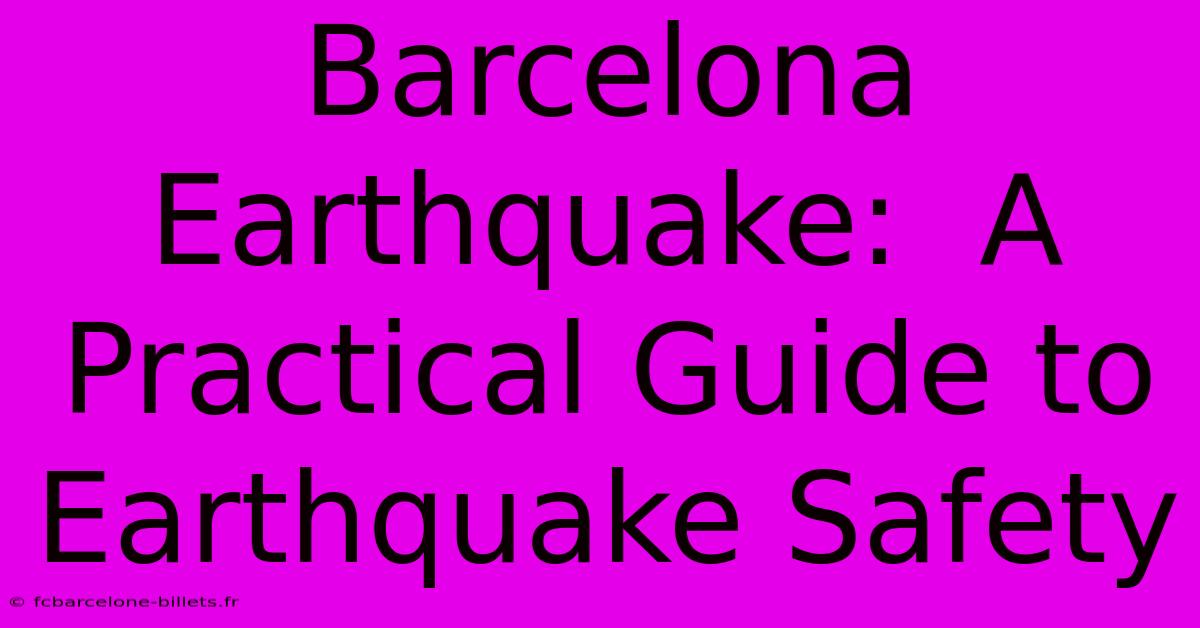Barcelona Earthquake: A Practical Guide To Earthquake Safety

Table of Contents
Barcelona Earthquake: A Practical Guide to Earthquake Safety
Barcelona, a city known for its vibrant culture and stunning architecture, sits in a region with a history of seismic activity. While major earthquakes are infrequent, understanding earthquake safety is crucial for residents and visitors alike. This guide provides practical steps to prepare for, survive, and recover from an earthquake in Barcelona.
Understanding Barcelona's Earthquake Risk
While not located on a major fault line like California, Barcelona experiences minor tremors periodically. The Iberian Peninsula is susceptible to seismic activity, and historical records indicate past earthquakes impacting the region, albeit often of low magnitude. However, the potential for a more significant earthquake cannot be dismissed. Knowing this risk is the first step towards preparedness.
Identifying Potential Hazards in Your Home or Workplace
Before an earthquake strikes, assess your surroundings. Identify potential hazards that could cause injury or damage during an earthquake:
- Unstable objects: Bookshelves, tall furniture, hanging objects (mirrors, pictures) can fall and cause injuries. Secure them to walls or remove them.
- Heavy appliances: Refrigerators, washing machines, and other heavy appliances can shift during an earthquake, causing damage. Secure them with straps or place them against a sturdy wall.
- Broken glass and sharp objects: Store these items securely to prevent injuries from broken glass or sharp objects falling during shaking.
- Gas and electrical lines: Know the location of your main gas and electrical shutoff valves. Learn how to turn them off safely in case of leaks or damage.
- Escape routes: Plan your escape routes from your home, workplace, or any frequently visited locations. Identify safe zones within buildings, away from windows and heavy objects.
Earthquake Preparedness: Steps You Can Take
Preparation is key to surviving an earthquake. Here's a practical checklist:
Creating an Emergency Plan:
- Family communication plan: Establish a meeting point outside your home and designate an out-of-town contact person to check in with family members.
- Emergency kit: Assemble a kit including water (one gallon per person per day for at least three days), non-perishable food, a first-aid kit, a flashlight, a battery-powered radio, extra batteries, essential medications, copies of important documents (ID, insurance), and cash.
- First-aid training: Consider taking a first-aid and CPR course. Knowing how to provide basic medical care can be lifesaving during emergencies.
Securing Your Home:
- Reinforce shelves and cabinets: Use brackets or straps to secure them to the walls.
- Install strong door latches: Ensure doors can withstand strong shaking.
- Brace tall furniture: Prevent them from tipping over by using straps or anchors.
During an Earthquake: What to Do
When an earthquake strikes, remember to stay calm and follow these guidelines:
- Drop, cover, and hold on: Drop to the ground, take cover under a sturdy table or desk, and hold on until the shaking stops.
- Stay away from windows and exterior walls: These areas are prone to damage.
- If you're outside, move away from buildings, trees, and power lines. Find an open space away from potential hazards.
- If you're in a car, pull over to a clear location and stop. Stay in your car until the shaking stops.
After an Earthquake: Recovery and Safety
After the shaking stops, prioritize safety and aid:
- Check for injuries: Provide first aid to anyone injured.
- Check for gas leaks: Smell for gas; if you detect a leak, evacuate immediately and contact the emergency services.
- Check for structural damage: If your home is severely damaged, evacuate and seek shelter elsewhere.
- Stay informed: Monitor news reports and follow instructions from emergency officials.
- Be aware of aftershocks: Aftershocks can occur and can be just as dangerous.
Resources and Further Information
For more detailed information on earthquake preparedness and safety in Spain, you can consult resources provided by the Spanish government's emergency services.
By following these guidelines, you can significantly improve your safety and preparedness during an earthquake in Barcelona. Remember, being prepared is the best way to protect yourself and your loved ones.

Thank you for visiting our website wich cover about Barcelona Earthquake: A Practical Guide To Earthquake Safety. We hope the information provided has been useful to you. Feel free to contact us if you have any questions or need further assistance. See you next time and dont miss to bookmark.
Featured Posts
-
See Europe Differently Barcelona To Frankfurt Train
Apr 07, 2025
-
Casa De Cambio Barcelona Open 7 Days A Week
Apr 07, 2025
-
Catch The Action Live Barcelona Vs Real Sociedad Tickets
Apr 07, 2025
-
Handcrafted In Barcelona The Toni Pons Espadrille Story
Apr 07, 2025
-
Barcelonas Gothic Quarter 4 Day Exploration
Apr 07, 2025
